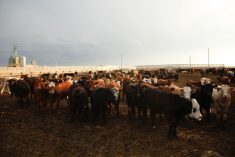Compared to last week, western Canadian yearling markets traded $2-$4 on either side of unchanged; mid-weight calves were also unchanged while lighter calves traded steady to as much as $6 higher.
Alberta and Saskatchewan have experienced adverse weather over the past couple of weeks; however, feedlots in southern Alberta appeared to be more aggressive for calves under 600 pounds. Yearlings are a second thought at this time of year and there are limited supplies available; there is limited supply but there is minimal demand. The calf market has become a different story. Cattle buyers were busy with orders for light-weight bawlers and no price limits were placed on the 400- to 500-pounders. Calves with full health program carried a premium this past week, especially in the non-major feeding areas. At the same time, the health risk in transporting feeder cattle long distances decreases as winter progresses. Once these animals have adjusted to current conditions, buyers feel more comfortable on shipping. U.S. feeder markets were up $2-$5 last week as well, leading Canadian values.
Read Also

Alberta crop conditions improve: report
Varied precipitation and warm temperatures were generally beneficial for crop development across Alberta during the week ended July 8, according to the latest provincial crop report released July 11.
In central Alberta, Charolais steers with medium flesh weighing just over 900 lbs. were quoted at $173; mixed medium-frame heifers with heavier butter weighing 895 lbs. were quoted at $156. In southern Alberta, larger-frame medium-flesh Simmental blended steers averaging 830 lbs. were quoted at $182. Fresh-off-grass yearlings are finished with winter conditions settling across the Prairies; the market for these cattle feels sluggish because feedlots can’t push them early in the feeding cycle.
In northwestern Manitoba, Hereford-blended steers averaging 650 lbs. were valued at $198 and Charolais-based heifers weighing 655 lbs. were quoted at $186. In central Alberta, semi-weaned, age-verified tan mixed steers with full health program weighing 670 lbs. were valued at $195 and similar-quality heifers weighing 630 lbs. were reported at $180. In southern Alberta, Angus-based age-verified full health steers weighing 510 lbs. were quoted at $228 and similar-quality heifers weighing just over 500 lbs. were quoted at $200. In central Saskatchewan, black steers weighing 450 lbs. were quoted at $255 and similar-quality and -weight heifers were valued at $206. The calf market was fairly even across the Prairies but prices were $5-$10 higher in the Lethbridge area.
We’ve seen a US$15 rally in feeder cattle futures and the U.S. Department of Agriculture’s WASDE (world agricultural supply and demand estimates) report confirmed a year-over-year decline in 2021 third- and fourth-quarter beef production. Next year, the market will digest the lower calf crops on both sides of the border. Corn fundamentals are now considered bullish and the feed grains complex cannot afford a crop problem in South America.
— Jerry Klassen manages the Canadian office of Swiss-based grain trader GAP SA Grains and Produits Ltd. and is president and founder of Resilient Capital, specializing in proprietary commodity futures trading and market analysis. Jerry consults with feedlots on risk management and writes a weekly cattle market commentary. He can be reached at 204-504-8339 or via his website at ResilCapital.com.















